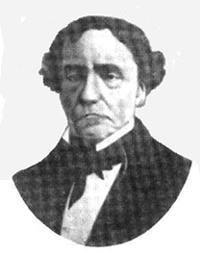José Francisco Barrundia y Cepeda
José Francisco Barrundia y Cepeda (* 1787 in Guatemala City , † September 4, 1854 in New York ) was a Central American president .
Life
Francisco Barrundia was born in Guatemala City , the son of Martín Barrundia and Teresa Cepeda . He was a brother of Juan Barrundia , who was head of state of the province of Guatemala in 1829 . Francisco Barrundia attended the Colegio Tridentino, where he graduated in philosophy on March 19, 1803. He was very educated and spoke several languages.
Political rise
Barrundia was one of the supporters of the Central American independence movement early on. In December 1813 , the then dragoon ensign and councilor ( Regidor ) of Guatemala City took part in the so-called " Conjuración de Belén " initiated by the Nicaraguan priest Tomás Ruíz . After their failure, he was arrested and sentenced to death by the Garrotte . However, thanks to the intervention of influential friends from the local council, the sentence was not carried out. However, he remained in custody for a long time.
From July 1820 he worked on the liberal newspapers "El Editor Constitucional" and "El Genio de la Libertad" published by the doctor Pedro Molina .
Barrundia was one of the signatories of the Central American Declaration of Independence on September 15, 1821 . He rejected Central America's annexation to the Mexican Empire, which was subsequently operated by Gabino Gaínza and other conservatives, and instead advocated the establishment of an independent federal state modeled on the United States .
After the fall of the Mexican Emperor Agustín I and the independence of Central America from Mexico in 1823, Barrundia was, together with Pedro Molina, one of the leading figures of the Liberal Party and a member of the Federation Parliament for them. There he campaigned for the adoption of the constitution of the "United Republics of Central America" from 1824.
President of Central America
In 1825 Barrundia was elected deputy to the first president of the Central American Confederation, Liberal Manuel José Arce , but did not accept the election. Together with Pedro Molina and other leading members of the Liberal Party in the Federation Parliament, he sharply criticized Arce's increasingly conservative policies. This led to the - unconstitutional - dissolution of parliament by Arce in October 1826 and the ensuing outbreak of civil war.
After the overthrow of Arces by the liberal head of state of Honduras Francisco Morazán and his two-month interregnum, Barrundia was appointed interim president of the Federation on June 29, 1829 with the constitutional mandate to call new elections. These took place in mid-July 1830 and ended with Morazán's election victory. On September 16, 1830 Barrundia handed this over the presidency.
Further political activity
During the first term of office of the Guatemalan head of state Mariano Gálvez from 1831 to 1835 Barrundia was a member of the state government as education minister. During this time he devoted himself to the translation of the Livingston Code (a penal code developed by Edward Livingston for the US state of Louisiana from 1821 to 1824 ) into Spanish with the aim of applying it in Central America.
In the following years, however, there was a falling out between Barrundia and Gálvez. This led Barrundia - like Pedro Molina - increasingly to the conservative party and distanced themselves from Gálvez 'government. Finally, Barrundia and Molina contributed to the overthrow of Gálvez 'in 1838, whereby they - unintentionally - helped the later Conservative President Rafael Carrera to rise.
As a member of the state parliament of Guatemala, Barrundia submitted a motion in 1839 to declare Guatemala a free, independent and sovereign state (and thus to resolve Guatemala's exit from the Central American Confederation), which was then adopted by a majority.
In 1848 Barrundia founded the "Album Republicano" newspaper .
Barrundia was most recently the Honduras ambassador to Washington . He died in New York in 1854 . His remains were transferred to Guatemala in 1913 on the initiative of then President Manuel Estrada .
Web links
- Francisco Barrundia on the website of the Guatemalan government (Spanish)
literature
- Hector Gaitán A., Los Presidentes de Guatemala. Artemis & Edinter, Guatemala 1992, ISBN 84-89452-25-3
| predecessor | Office | successor |
|---|---|---|
| José Francisco Morazán Quezada |
Presidents of Central America June 29, 1829 - September 16, 1830 |
José Francisco Morazán Quezada |
| personal data | |
|---|---|
| SURNAME | Barrundia y Cepeda, José Francisco |
| BRIEF DESCRIPTION | Central American President |
| DATE OF BIRTH | 1787 |
| PLACE OF BIRTH | Guatemala City |
| DATE OF DEATH | September 4, 1854 |
| Place of death | new York |
